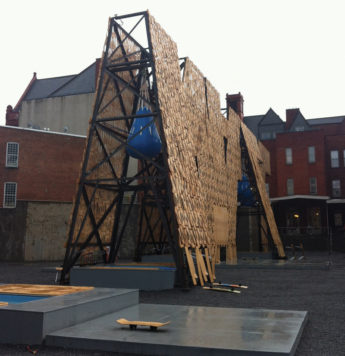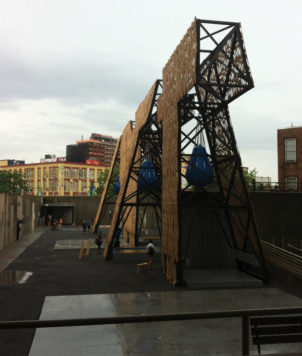DESIGN AND CONCEPT Nilay Lawson
STUDENT EDITOR Dylan Kahn ’16
RESEARCH Sarah Green ’18
Each student contributor was a member of a writing seminar taken during their freshman year, led by Postdoctoral Writing Fellow Paul M. Farber: “Memory, Monuments, and Urban Space” and “Cultural Approaches to Divided Cities.”
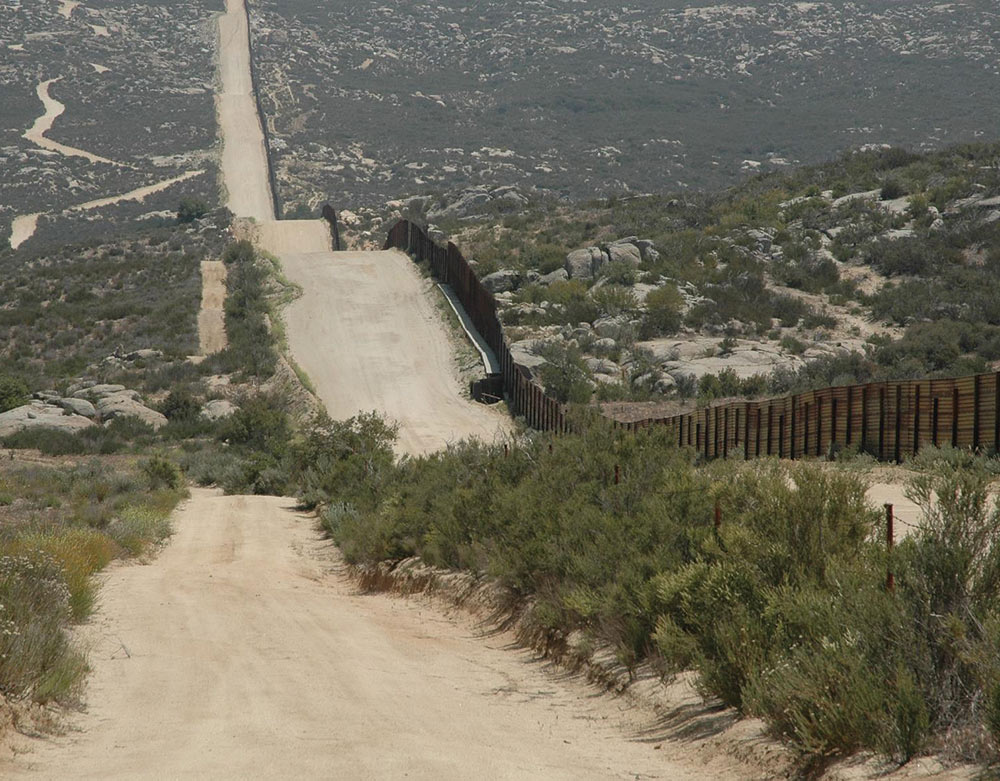
BORDERLAND
Karen Mondaca ’18
I am the product of a borderland, not fully recognized as Mexican nor American. Not fully accepted in Mexico nor America. To fully understand the binary of borders, specifically the border between Mexico and America, one must first comprehend what happens when borders are created, both physically and mentally. Gloria Anzaldúa says,
Borders are set up to define the places that are safe and unsafe, to distinguish us from them. A border is a dividing line, a narrow strip along a steep edge. A borderland is a vague and undetermined place created by the emotional residue of an unnatural boundary. It is in a constant state of transition. The prohibited and the forbidden are its inhabitants.[1]
She writes about the gray area filled with hurt and confusion that arises from the clashing of two cultures. She then cites Confederate Major General William H. Wharton and his quote “The Anglo-American race are destined to be forever the proprietors of this land of promise and fulfillment. Their laws will govern it, their learning will enlighten it, their enterprise will improve it.”[2] This is noticeable in the way that Mexico has taken on the English language and some of America’s customs. This is especially true at the border. With people coming and going from both sides, a new culture arises: a Chicano culture, where the language spoken by those who inhabit the borderlands is a combination of English and Spanish but is not necessarily “Spanglish.” These border dwellers don’t belong to the American nor Mexican cultures but live in the grayness between the two.
For those Mexicans who make it to the United States, Anzaldúa says,
Those who make it past the checking points of the Border Patrol find themselves in the midst of 150 years of racism in Chicano barrios in the Southwest and in big northern cities. Living in a no-man’s-borderland, caught between being treated as criminals and being able to eat, between resistance and deportation, the illegal refugees are some of the poorest and the most exploited of any people in the U.S.[1]
Despite coming to the United States, Mexicans could not find justice. First and second generation Chicanos are those who live in a constant state of gray. They consider America, as some form of homeland, but their roots keep tugging them to Mexico. It is hard to feel part of one culture or another when the borderland continuously pushes away and asks more of its inhabitants.
It is not safe for the lesser of the two in a binary and for those who are stuck in a gray area to have pieces of themselves scattered across borders. They are no more accepted for their assimilation or acculturation. What would happen if the border were removed, would anything change? Is the physical border also a mental border that distinguishes between ‘us’ and ‘them’ on both sides?
- Gloria Anzaldúa. Borderlands/La Frontera: The New Mestiza (San Francisco: Spinsters/Aunt Lute, 1987), 3. ↑
- Anzaldúa, Borderlands, 29. ↑
- Anzaldúa, Borderlands, 34. ↑
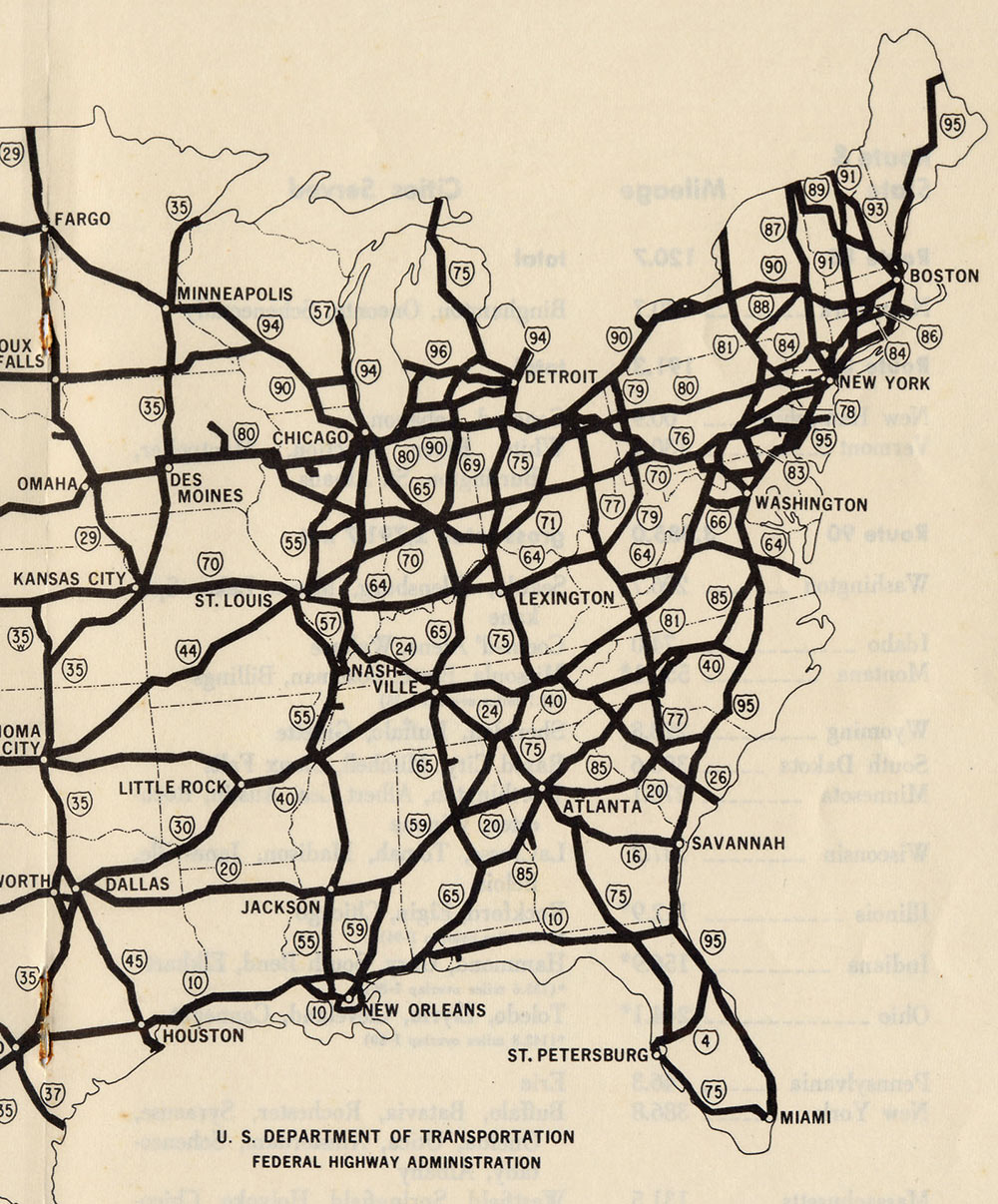
INTERSTATE
Andrew Chalfoun ’18
What could look less like a barrier than the Interstate Highway System? The interstate exists at the heart of United States transportation, bringing the nation together and building connections between disparate communities. It is the centerpiece of the American myth of the open road, providing an escape from the day to day through the possibility of traveling into the great unknown. Yet the interstate and its connected highways also exist as a site of division and as a barrier. Particularly in the realm of urban highway construction, its history has been one of violence, of destroyed communities, and of isolated individuals.
In his biography of the New York architect Robert Moses, The Power Broker, author Robert Caro provides a glimpse of the destructive power that was necessary to construct American highways. In the chapter, “One Mile,” Caro describes the building of the Cross-Bronx Expressway through the predominantly Jewish neighborhood of East Tremont, which, until highway construction began in the mid-1950s, was a relatively successful and close-knit community. In the course of the construction of a mile long section of Cross-Bronx Expressway within East Tremont, 1530 families were forcibly displaced.[1] This displacement tore apart the fabric of the neighborhood, dispersing the former residents. The project of highway construction encouraged the neglect of the local infrastructure, leaving East Tremont in shambles by 1965, as if “troops had fought their way through it from house to house.”[2]
East Tremont is but one case among many. In the light of East Tremont and examples like it, we must move beyond the idea that the interstate is simply a societal connector. It is necessary for us to consider the destructive history of the highway as barrier and wall before we can truly understand the meaning of “Interstate.” The massive transformation of the landscape wrought by the interstate project often obscures this history, for the new highways and surrounding infrastructure replaced and obliterated the physical representations of the history that came before. As historian Eric Avila points out while speaking of African-American communities that faced highway construction, “highway construction… imposed another break in the lived experience of historical time,” cutting off those who experienced it from their community’s past.[3] We cannot leave this break in place nor forget what existed before it. It must be our task to understand the highway in its full effect and take action to heal the damage we have wrought in the name of its apparent convenience.
- Robert Caro. The Power Broker: Robert Moses and the Fall of New York. (New York: Alfred A. Knopf, Inc.: 1974), 881. ↑
- Caro, The Power Broker, 893. ↑
- Eric Avila. The Folklore of the Freeway: Race and Revolt in the Modernist City (Minneapolis, Minnesota: University of Minnesota Press: 2014) 100. ↑
REVITALIZATION
Jessie Lamworth ’18
In 1959, Frank Lloyd Wright revolutionized the museum wall by conceptualizing the cascading circular ramp inside New York’s Guggenheim Museum. In place of Beaux-Arts Palace right-angled walls, Wright imagined an expressive yet personal space in which visitors could view individual artworks and the museum’s interior walls from the same location. Forty years ago, Wright took a stark, monotonous concept of a wall and transformed it into an imaginative, compelling environment. It’s time for the rebirth of this type of innovative architecture, especially in the context of borders and fences. Architecture controls us through harmonization of form and function, defining our attitudes and actions through a structuring of our physical surroundings.
Architectural reimagining involves dimensionality. A wall can be multi-purposed and can vary in size, material, and form. A barrier entitled Party Wall, located in the courtyard of MoMA PS1 in New York, is a steel-framed structure covered in wooden skateboard scraps, which functions as a giant aqueduct. Built in 2013, Party Wall is intricately designed such that certain panels in the structure can be detached and used as benches, communal tables, and a series of small-scale performance stages. The piece provides shelter and shade while still functioning as a demarcating “wall.”
Creative wall architecture can also mean contextualization. Notably, a deteriorated historic building in the city of Porto, Portugal was transformed and structurally revitalized in 2015 through the addition of a multi-storied, six-ton green metal fence. The design firm, FAHR, sought to “draw public attention to [socio-economic] issues through a project that ‘dignified’ the space,” which provoked thought about the contradiction of enclosure.[1] The simple juxtaposition in the placement of a bright, modern, grid-like fence atop a timeworn, greying building stimulates the interaction between spaces on either side. Aptly entitled Metamorfose, the giant green fence identifies the fluctuating landscape of a socially diverse city.
The Sean Collier Memorial, situated on M.I.T.’s campus, is a five-walled barrier that succeeds in including, commemorating, and inciting meditation. Comprised of thirty-two seamlessly fitted keystone blocks arranged in five-arched geometry, the memorial, built in the spring of 2015, serves as a public space for grievance and remembrance in honor of Collier, an M.I.T police officer killed in the line of duty. The chief designer, J. Meejin Yoon, says that the monument stands as a symbol of “openness in the face of threat, unity through diversity, and strength through community.”[2] Despite the wall’s immediate appearance as an established barrier, it achieves an air of solemnity, respect, and community.
Party Wall, Metamorfose, and Sean Collier Memorial are all examples of how beautiful, critical architecture has transformed the meaning of the word “wall,” much like Frank Lloyd Wright did in the Guggenheim. There are several more examples of revitalized walls in the world today and hopefully many more to come. In order to deconstruct limitations in our minds, we must construct innovative spaces in which to change our mindset. The assumptions about spaces, especially those that act as borders, must be broken down in order to stimulate conversation and ideation.
- Jelena Savi, “FAHR 021.3: Stimulating urban environments,” CAMOCnews (March 2015), 21. ↑
- J. Meejin Yoon, “Sean Collier Memorial,” M.I.T. Architecture. <http://architecture.mit.edu/project/sean-collier-memorial>. ↑
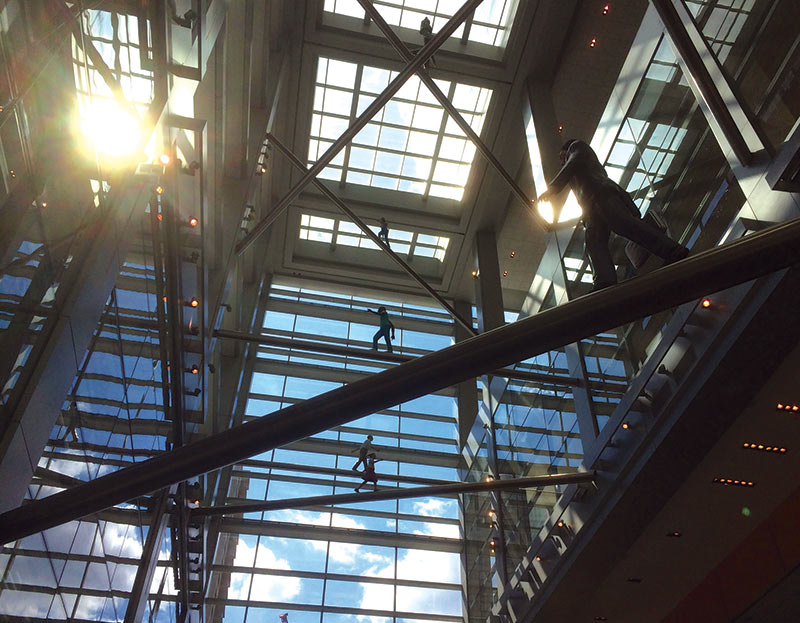
PUBLIC
Freda Coren ’17
The word public implies accessibility and visibility. Frequently, it invokes a connection to government funding or control, to open spaces, and to transparency. If public—as in public art, public health, your public library—connotes universal accessibility, its antonym private could signify personal or corporate funding and restricted accessibility. However, in public space and in public art the divisions between public and private are often ambiguous.
The ambiguity between public and private space complicates issues of ownership and entry. A person’s right to enter or alter a given space (as with most public art), and the repercussions for doing so, seem to depend more on the ownership of the space rather than its apparent function. This tension between the legal and functional characteristics of a space inspired urban planning and design professor Jerold S. Kayden’s concept of “privately owned public space.” While Kayden refers specifically to the transformation of public space in New York City in the 1960s after the passing of new zoning laws, his notion applies to various spaces whose proprietors and purposes trouble a conventional notion of public space.[1]
To push and confuse this duality, I ask, is the Berlin Wall a public space? Even examining the Berlin Wall solely from the perspective of those interacting with it in West Berlin, the answer is unclear. Different sections of the Wall were monitored by the militaries of different governments—the western side of the Wall was not under the same vigilance and threat as the eastern; even in the supposedly liberated West, the Berlin Wall cannot be easily defined as public space. However, was the art created on the surface of the Berlin Wall
public, even if its canvas was not?
American artist Jonathan Borofsky challenged the Berlin Wall’s ill-defined control when, in 1982, he painted the iconic Running Man on the Wall. In a recent interview with curator Paul Farber, Borofsky recalls that he had to paint in the middle of the night in order to evade British military patrol. He was, in fact, confronted by the military, but pleaded for more time to finish the piece. The military guards who decided to look the other way so that Borofsky and his assistants could finish the piece further complicate the Wall’s ownership and control.[2]
Twenty-six years later, in 2008, Borofsky was commissioned to create the permanent installation Humanity in Motion in Philadelphia’s Comcast Center, in which life-size representations of humans are suspended, mid-step, in their trajectories within a tall glass atrium above the building’s lobby. Like Running Man, these figures are publicly visible and trapped in motion. I ask, then, can public art exist within a private space?
Many public spaces and spectacles of public art exist in the murky zone between public and private. Some of these spaces appear pristine and inviting; others, like the Berlin Wall, foreboding and dangerous. Yet, despite imposed or imagined restrictions of access to these spaces, they are frequently flooded by art and invite the public to examine and be part of the space, regardless of ownership.
- Jerold S. Kayden, the New York City Department of City Planning, and the Municipal Art Society of New York, Privately Owned Public Space: The New York City Experience (New York, NY: John Wiley & Sons, Inc., 2000), 1. ↑
- Jonathan Borofsky, interview with Paul Farber, 2015. http://architecture.mit.edu/project/sean-collier-memorial. ↑
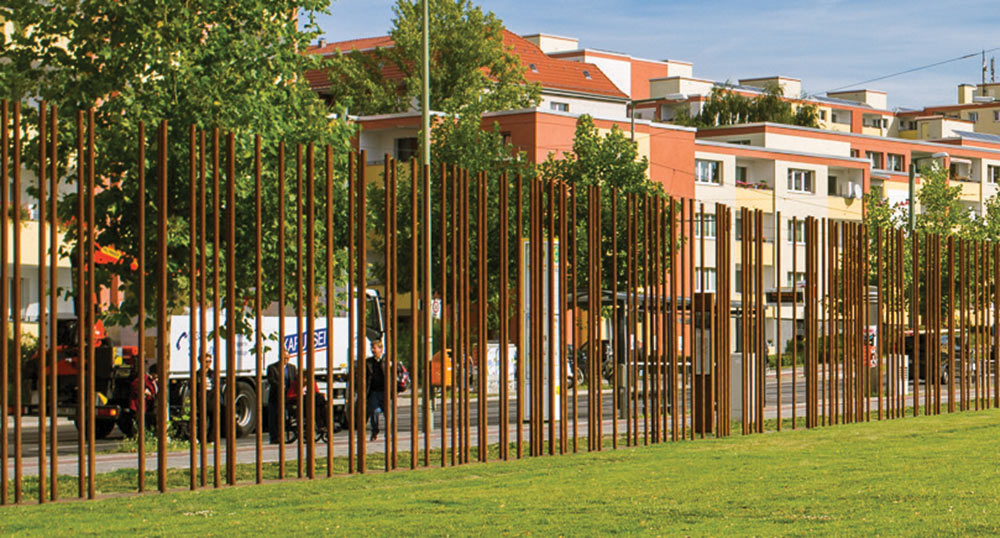
VOID
John Halifax ’18
By creating explicit boundaries in what was once open space, a wall divides. It divides and in doing so, creates a void. Two separate entities are formed, and where the flourish of interactions once existed, an emptiness remains. This void took a physical form in the “death strip” of the Berlin Wall, and this cavity can be extended into wider human consciousness through its abstraction in the work of Adrian Piper.
With the erection of the Berlin Wall, the German capital was cut in half. From one, two disparate urban centers were created, but in between them was a no man’s land. The world’s most famous barrier was in fact several walls, with a so called “death strip” about 150 yards wide filling the space in between. Deprived of urban normality, the death strip was instead littered by anti-tank barricades, trenches, observation towers, and patrol paths, the barrenness all constantly illuminated by unblinking light arrays. The city wasn’t simply divided: Part of it was sacrificed and rendered completely barren of all signs of human metropolis in order to achieve this division. As Olaf Briese describes, “It was an urban cannula filled with nothing but anti-city.”[1]
Such a sacrifice of space is mirrored in Adrian Piper’s piece in this exhibition, Everything #5. In the artwork a plate of plexiglass with the words “Everything Will Be Taken Away” etched in gold leaf is set into the very wall of the gallery, offering a window past the uniformly painted plaster and into the flesh of the building. Whereas the Berlin Wall left the city with an empty space, Piper’s work rips up the blankness of the gallery wall and inscribes a nothing. The gallery wall is not destroyed, but a hollowness is achieved that haunts the viewer.
The glass plate, much like the Berlin Wall, creates a sense of division that had previously not existed. When, in 1961, a dense collection of homes, businesses, and other buildings blended together, the erection of the Berlin Wall redefined space in the city. So, too, in the gallery. The interior of the gallery wall is normally out of the mind of the viewer, with the partitions seeming as mere suggestions of organization in the openness and flexibility of the space. Everything #5 challenges this fluidity by exposing what lies behind the wall. The physical change is minimal, but the space is definitively altered.
In 1989, in an apparent confirmation of Western ideals, the Wall was ripped apart by the masses it once segregated. As Germany reunified and the Iron Curtain rusted into oblivion, the void of the death strip was left bereft of purpose. Berlin’s wound of nothingness was stitched together to unite the city, and with capitalism in ascendency, the vacuum was replaced, as Daniel Schwaag puts it, by “the sterility of institutional campuses, condominiums, discount marts, and prefabricated model homes.”[2] Such a transformation into the stale and ordinary will eventually consume Piper’s Everything #5. Exhibitions end—with greater frequency and organization than worldwide political struggles—and the gallery space returns to white blankness. Eventually, Piper’s plexiglass will be removed, the void plastered over with little evidence left of what once transformed the space. Yet those fortunate enough to see the piece and then return to gallery after its removal will not see the space in the same way. As Ian Warner writes, “where the banality stops, an ‘experience’ begins.”[3] Just as the contrived, corporate box homes of the filled-in death strip still leave sense of what was before, the sense of void will linger in the Cantor-Fitzgerald Gallery after The Wall in Our Heads ends. The previously confined, finite space is thrown into question by the glaring emptiness of Everything #5, and while the wall may be patched in the future, the image of what hides behind the partition’s reality will nag at all those who looked beyond the plexiglass.
- Olaf Briese, “The Different Aesthetics of the Berlin Wall,” in The German Wall: Fallout in Europe, ed. Marc Silberman (New York, NY: Palgrave Macmillan, 2011), 47. ↑
- Oliver Miller, Daniel Schwaag, and Ian Warner, The New Death Strip (Berlin, AdBK, 2011), 25. ↑
- Miller, Schwaag, Warner, The New Death Strip, 27. ↑
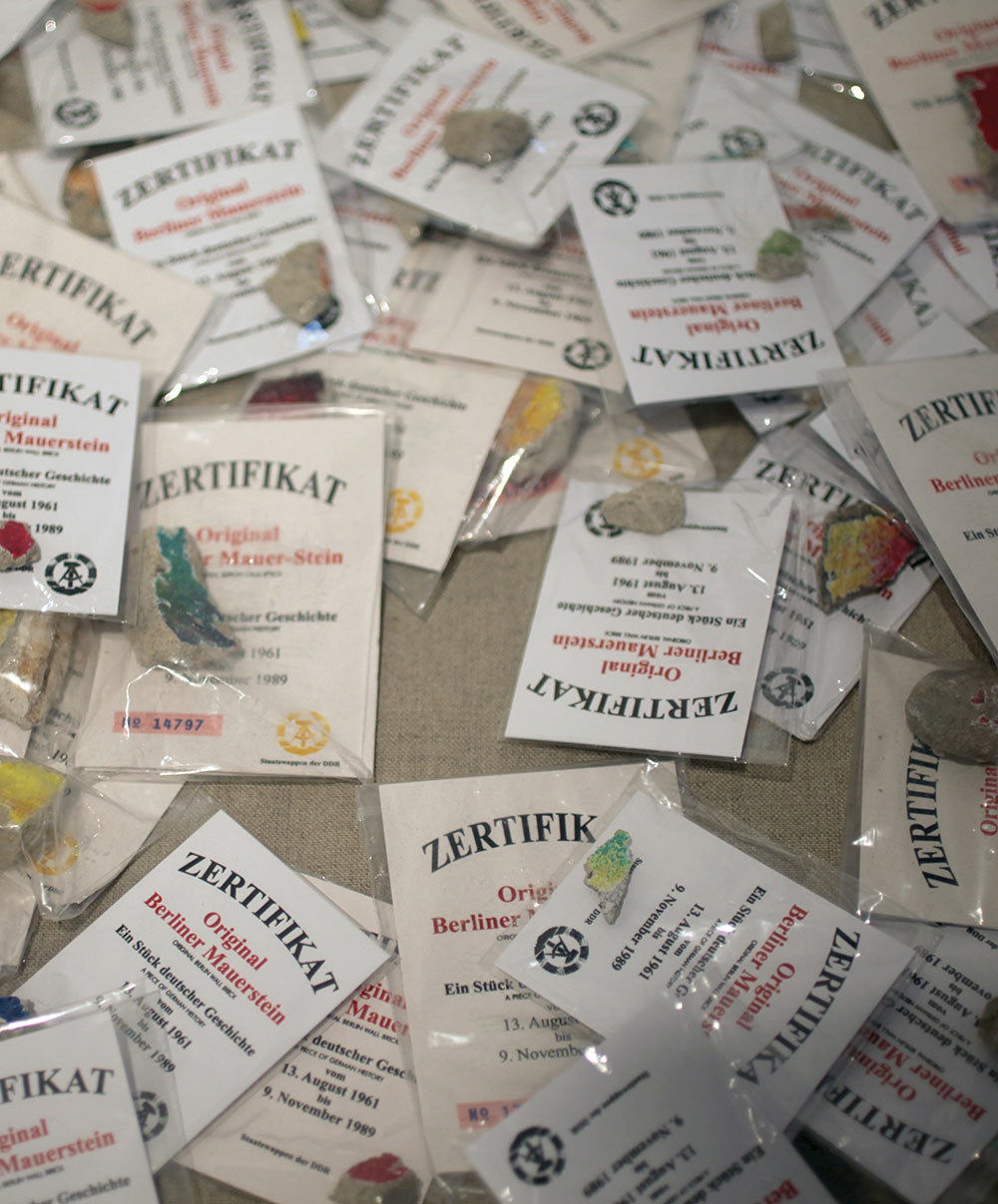
DIASPORA
Catheline Phan ’18
What do you envision when you hear the words, “Berlin Wall?” Public memory remembers it as an imposing Goliath, looming over the soil of a nation irrevocably divided in two.
Historically, the construction and eventual fall of the Berlin Wall is a well-trodden narrative of triumph and loss—of a nation separated and later reunited. The postwar viewpoint engages in a lurid love affair with the concept of division at its center—we’ve become so enamored with viewing it in terms of limits and restrictions that no other possibilities readily come to mind.
In memory, the Wall acts as an insurmountable border keeping people within; its sheer tangibility thwarts any attempts to cross. Even now in its monumental ruins, the structure has become a “living enclosure”—both from a historical standpoint with its layers of physically evolving structural revisions and from a conceptual standpoint as an enduring symbol within contemporary society.
But what if we took a moment to contemplate the Wall as a means of travel? If we viewed it as a nexus for bringing people and things together? In the days before the Wall, thousands of people had already migrated between East and West Berlin—the structure partially succeeded in impeding movement for some, but for others the impulse to traverse the border was continually present. With a shift in perspective, a division becomes a gap to be crossed. One rarely-discussed example of how drastically a narrative frame influences the interpretation of context is the naming scheme for the Wall: the West dubbed it the “Berlin Wall,” while the East referred to it as the “Anti-Fascist Protective Rampart.”
In some ways, that gap in our knowledge and our first assumptions transform into an invitation, awakening a fascination with the unknown—in this sense, the concept of diaspora is represented. Traditionally, diaspora is the way we understand how, and perhaps why, communities exist despite and across dispersal. However, I want to repurpose the word as an organizing principle of identity, reflecting and defining the concept through movement and division, spatial and temporal relations, and for both people and objects.
Communities are, in part, defined by their division and society’s historical knowledge of their movement. The Berlin Wall is a source for such a community, allowing individuals to piece together a strong sense of identity through both movement away from the city but also through a return to revisit its existence. The Wall’s physical existence did more than only prompt travel—by creating identity on both sides of the barrier, it also affected the way we look across time and distance.
So, what is the “diaspora of the Wall?” Is it a rumination of division, or about the ownership of that division?
What if we read the Wall not just through its later dispersal but through its attempt to glue something together? Unlike what the “diaspora of the Wall” suggests, what I refer to as diaspora is not just one secluded event in history. What does diaspora mean for the Wall in a broader sense? Diaspora becomes a tool for understanding both the history and memory surrounding the Wall’s multiple contexts.
People cross. Objects cross. Both travel across borders, each carrying their own identities.
If one were to read a map tracing the pieces’ movements across the world, that in itself could be classified as diasporic. Artist Stephanie Syjuco’s Berlin Wall work dramatizes the vision of what I think diaspora can be.
A subsection of Syjuco’s Berlin Wall “fragments” featured in The Wall in Our Heads serve as an especially prominent example of diaspora and the conundrums that engulf the concept. Among her fabricated Wall pieces are those from demolished Soviet-era Polish buildings and packaged as souvenirs. That, in itself, conjures up an entirely different identity—these fragments are removed temporally and geographically from the historic Berlin Wall. Every item has a documented history embedded within its structure, and these chips should be no different—yet, they are. If an object’s value supposedly derives from its journey, shouldn’t the same rule apply for these pieces?
The worn-down aesthetic. The lurid spray-painted color schemes—all of these elements contained in the Wall pieces should rightfully remind the viewer of cheap trinkets. The goal is not to present a pristine art object, both in the sense of physical quality and historical meaning, but to devise a tool to reexamine the history and memory of the Berlin Wall. Once coated in fresh paint, falsely labeled as “Zertifikat—Original Berliner Mauer-Stein” and proudly displayed in a vitrine, what were once banal remnants of urban decay in an entirely different country vanish from site-specific memory and context. Obscured by our fixation with a preconceptual idea of Berlin, we find authority in imperfection and assign an entirely new (and perhaps unwarranted) identity to these objects.
Ultimately, questions about authenticity and identity arise. None of the pieces themselves have labels “naming” their diaspora—all traces of whatever Soviet or Polish heritage had existed before are now masked by the packaging. So, what does it mean to be an “original?” Or a “copy?”
Syjuco’s work highlights the complexity of this dynamic. What does it mean that it is so deceptively easy to completely discard one’s origins? Does diaspora strengthen one’s sense of identity through evoking distance from a lost homeland, defining a new, rich meaning through the juxtaposition of cultures? Or, are the “new” labels so overwhelming that all sense of the original self is lost by the very process of redefinition?
UNIVERSITY CITY HIGH SCHOOL
Sarah Green ’18
Art exists as a mechanism for crossing borders, for bridging gaps, for making sense of division through expression and creative genesis. Division, in its most basic form, seeks destruction—the severing of a bond, the building of a wall. But division may also inspire creation.
The Berlin Wall, often cited as one of the most prominent and visible representations of physical and ideological division, created two parallel worlds—paradoxically connected by violent separation, split along the line of a formidable barrier, one that extended not only through the physical landscape of Germany but through the minds and bodies of those who lived in its shadow. Decades after its demolition, the ideological remnants of the Wall have spread beyond Germany, moving to the background, subtly maintaining division
in urban space.
Philadelphia, one city of many to have been touched by division, bears the Wall’s legacy to this day. This Wall weaves its way through the city not in the form of obvious physical barriers but in chain link fences, public transit routes, neighborhoods, street names, school districts. For example, Black Bottom, a historically prominent black community in West Philadelphia, is now University City, a modern urban campus for Drexel and the University of Pennsylvania. The former University City High School, an attempt by the black community to reclaim its former identity, is now a demolition site.
When I returned to the school, after demolition had begun, the idyllic blue sky above the chain link fence surrounding the school’s former border seemed to mock the scene that lay in front of me. Before today, I had never stumbled upon a space that I could definitively call a wasteland. But that is what UCHS has become. The mosaic murals that once brightened the school’s massive brick walls, detailing the history of displacement and loss suffered by the Black Bottom community, lay in a pile of rubble, pulverized beyond recognition, beyond meaning. I tried—and failed—to scout out even one tile still glittering among the debris.
One nearly-intact corner of the building still stood defiantly upright among the ruins of the school, a grim reminder of what once was. The bricks still clung together, providing some semblance of fortitude. A shattered window looked out on the levelled landscape behind the fence. A set of cement stairs led to a doorway, an entrance to nowhere, a threshold between the past and an uncertain future.
But even in its current state of ruin, the school’s rubble exudes an overwhelming sense of importance. The debris creates an ephemeral monument to past loss and loss still to come—loss of a community, loss of self-expression, loss of yet another battle against the creeping sprawl of Drexel’s campus. Drexel looms over UCHS—clean and modern and leering—waiting to leave its mark, to claim its stake, to build its wall on the remains of University City High School.
When art is not enough—to bridge a gap, to scale a wall, to heal the wounds of division—what is? How do we memorialize a wall that has only ever existed in our heads?
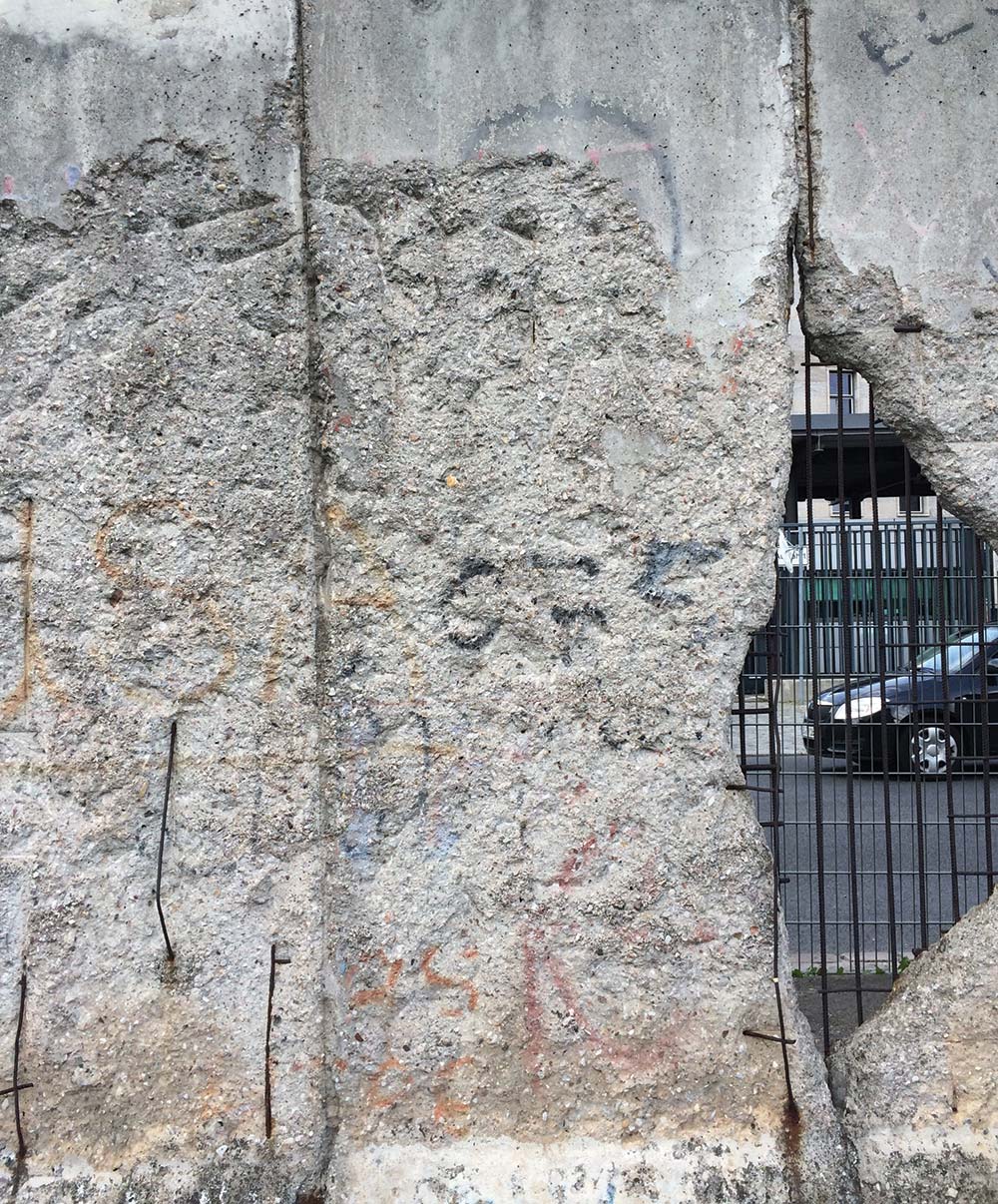
ACCOUNTABILITY
Alliyah Allen ’18
When questions arise of who should be held accountable during times of division, placing accountability on a group of people or one person proves to be a difficult task. In exercises of power and privilege, one may easily hold the oppressor accountable for discrimination, poverty, and limited access to full personhood and humanity. Division, in any context, automatically constructs a wall that defines differences as the primary identifying factor of a person’s existence. With that said, holding someone from a different group accountable becomes second nature, especially when two groups of people have been pitted against each other for an extended period of time. However, when division further fragments a community, accountability becomes more of a challenge than a solution.
Chuck D’s By the Time I Got to Arizona captures this challenge best by highlighting the damage done at the U.S.-Mexico Border through harsh immigration reform. Taking a deeper look at the U.S. side of the border, both race and the authoritative role of the police cause disruption. There are few points for connection. Now, when the question of accountability is proposed, it becomes more difficult to place because the amount of factors affecting the division has increased. In this artwork, not only does race play a role in who gets stopped by the police, but so do an individual’s class, gender, and other intersecting identities.
While the added layers of division complicate the role of accountability and of a solution, locating the truth becomes a dynamic element that constitutes a path to responsibility. Even though countless communities and nations have been divided, there rarely exists a true account in history that explains what led to the division and its actual impact. Toni Morrison, an American author, provides one of the best explanations for understanding truth; she writes, “the crucial distinction for me is not the difference between fact and fiction, but the distinction between fact and truth. Because facts can exist without human intelligence, but truth cannot.”[1] When we study immigration reform in the U.S.-Mexico context, we can easily look at the laws and statistics and make judgments about what’s happening in order to hold a party accountable. However, these facts will not give a true account as to how people actually felt, lived, and reacted toward those same factors.
Thus, truth becomes the only vehicle comprehensible for finding accountability for not just the physical or geographic divide but rather the divide that has become ingrained in our thoughts, actions, and beings. Chuck D, Morrison, and other artists are a few powerful examples of people using their expression as a means of holding themselves accountable for division. They are also choosing to spark critical thought for others to acknowledge their roles as well, which is an act leading toward true accountability.
- Toni Morrison, “The Site of Memory,” in Inventing the Truth: The Art and Craft of Memoir, 2nd ed., ed. William Zinsser (Boston; New York: Houghton Mifflin, 1995), 93. ↑

BERLIN WALL
Danny Rothschild ’15
The Berlin Wall was much more than a wall. Understanding what it was, however, continues to pose a challenge for Berliners, scholars, and other observers even now, twenty-six years after the Wall’s dismantling.
Part of the problem is that the structure, built by the East Germans (Deutsche Demokratische Republik, or DDR) did not do what either its common name (the “Berlin Wall”) or its official DDR designation (the “Anti-Fascist Protection Rampart”) would suggest. We call it “the Berlin Wall,” but most of it—seventy-two of the hundred miles—did not separate West Berlin from East Berlin, but rather West Berlin from the surrounding East German state of Brandenburg, and the vast majority of the Wall ran through Brandenburg territory, not through Berlin at all. Meanwhile, unlike most border structures, it was designed to keep its own population in, not to keep outsiders (fascist or otherwise) out. Physically, though, “in” and “out” were turned around: it encircled West Berlin, but the surrounding East Germans were the ones trapped by the Wall.
Finally, it was, in a literal sense, not a “wall,” or at least not only a wall. Instead, it was a complex apparatus that changed dramatically over its lifespan. In the first years after construction began in 1961, it was in many places little more than a guarded series of fences, but by 1989, when the Wall “fell”—another misnomer—it was made up of two parallel walls: an “inner” wall (Hinterlandsmauer) on the East German side (thus physically the outer ring) and a larger “outer”-which-is-to-say-inner wall facing West Berlin. Between the two was a large sandy patch containing guard towers with armed guards, anti-tank devices, electronic signal fences, and other obstacles to potential escapees; at least 136 people died at the Wall, most of them trying to flee, and so this area was known as the “death strip.”
Thus, the Berlin Wall was chiefly not a wall and most of it was not in Berlin; and so you can barely get past its name and its location before the unrelenting strangeness of the Berlin Wall begins erecting an “Anti-Comprehension Protection Rampart” in your mind. Being there, in the physical space the Wall once occupied and in some ways still occupies, only begins to tear down that wall.
This past summer, I engaged with the historical and physical remnants of the Wall through two related projects. First, I interned with a nonprofit that supports the preservation and expansion of Mauerpark, a communal, artistic, and historical space on a piece of the former death strip. Second, I walked the entirety of the Mauerweg in twelve consecutive counter-clockwise sections, on a trail constructed by the city of Berlin that closely follows the hundred-mile course of the Wall.
Each of these projects greatly deepened my sense of the Wall’s past and present physicality and geography. Explaining the history of the site to tourists and locals at the Friends of Mauerpark information booth every Sunday, I discovered just how unclear the Wall’s history was: Most of what is now Mauerpark was actually not part of the death strip until 1988, when a land exchange shifted the border there to the west. As a result, in 1989, when the Wall opened, there were actually three walls at this site. The former divisions have concrete implications today even in the banalities of urban development, touching everything from zoning disputes to the planned construction of a sewage tunnel under the park that is to run east-west and thus would have been impossible before 1989.
Walking the Mauerweg, too, taught me the obvious but generally overlooked fact of where the Wall actually was. It took me past famous sites like Checkpoint Charlie, the Brandenburg Gate, Potsdamer Platz, and, of course, Mauerpark, but most of it was nature trail or suburban road, cutting through neighborhoods that had long existed and along new ones that have sprouted up in the last twenty-five years. Along the trail, the Wall was remembered and memorialized in a variety of ways. I learned the most from sleepy local displays and memorials (most of which were written just in German) describing and showing what the Wall’s presence did to the rhythms of daily life in those neighborhoods; the official memorials often did little more than tally the dead. Mauerpark, too, which essentially turns into a public festival every Sunday in the summer, is itself a lively memorial to the Wall and its democratic dismantling.
The path and the park are powerful memorials but, like all memorials, limited in the kinds of memory they foster. Neither is especially useful for telling us what happened. At their most useful, they are, instead, landscapes where the past shoots up like weeds: easy to overlook but harder to get rid of.
In Summer 2015, Danny Rothschild was selected for a summer internship in Berlin supported by the Hurford Center for the Arts and Humanities and the Center for Peace and Global Citizenship, and facilitated by Postdoctoral Writing Fellow Paul M. Farber, titled “Divided City: Friends of Mauerpark.”

